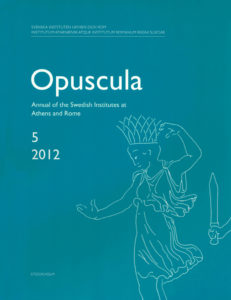 Opuscula is published by the Swedish Institutes at Athens and Rome, with the aid of a grant from the Swedish Research Council. Distributed by Eddy.se AB. View journal at ERIH PLUS. All content available with open access.
Opuscula is published by the Swedish Institutes at Athens and Rome, with the aid of a grant from the Swedish Research Council. Distributed by Eddy.se AB. View journal at ERIH PLUS. All content available with open access.
The Swedish Jordan Expedition 2009 and 2010 at Tall Abu al-Kharaz. Preliminary results from the Early Iron Age occupation in Area 9. With appendices by T. Bürge, and A. Gustafsson & J. Azzopardi
Abstract
Tall Abu al-Kharaz, in the central Jordan Valley, was occupied during approximately five millennia. A walled town, which had a dominant position in the Jordan Valley, existed already in the Early Bronze Age IB, viz. before 3050 BC. Walled settlements also flourished at the end of the Middle Bronze Age (around 1600 BC), during the Late Bronze Age (roughly 1500–1200 BC) and throughout the entire Iron Age (roughly 1200–600 BC). It is most likely that Tell Abu al-Kharaz is identical with Jabesh Gilead: this city is mentioned frequently in the Old Testament. During earlier seasons most of the Early Iron Age remains were found to have been disturbed by later settlers. It is, therefore, essential for the documentation of the settlement history of this city, that the expedition of 2009 unearthed an extremely well-preserved city quarter dating to the 12/11th century BC (according to high-precision radiocarbon dates). The excavations were extended in autumn 2010 and a stone-built, architectural compound was uncovered. Fourteen rooms (state October 2010), with walls still upright and standing to a height of more than 2 m, were exposed. The inventories of these rooms, which comprised more than one hundred complete vessels and other objects, were remarkably intact. Amongst the finds were numerous imports from Egypt and Lebanon. There are also finds which should be attributed to the Philistines, according to several Aegean-style vessels. The find context points to a hasty abandonment of the city. In the past, the beginning of the Iron Age has often been described as “the Dark Ages”—a period of cultural regression: this categorization is not relevant to the find situation at Tall Abu al-Kharaz where the remains of a wealthy society, which had far-reaching intercultural connections, can be identified.
Download PDF - Size: 2.49 MB - Downloads: 223 (since 2023)
Bibliographical information
Peter M. Fischer, ‘The Swedish Jordan Expedition 2009 and 2010 at Tall Abu al-Kharaz. Preliminary results from the Early Iron Age occupation in Area 9. With appendices by T. Bürge, and A. Gustafsson & J. Azzopardi’, Opuscula. Annual of the Swedish Institutes at Athens and Rome (OpAthRom) 5, 165–185. Stockholm 2012. ISSN: 2000-0898 ISBN: 978-91-977798-4-5. Softcover, 204 pages. https://doi.org/10.30549/opathrom-05-08

No Comments
Comments are closed.